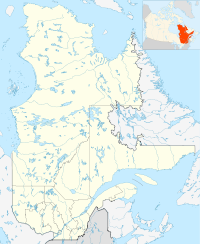- Matimekosh, Quebec
-
Matimekosh — Indian reserve — Matimekosh Reserve stretches from the centre of the photo to the airport on the right. 
FlagCoordinates: 54°48′30″N 66°49′25″W / 54.80833°N 66.82361°WCoordinates: 54°48′30″N 66°49′25″W / 54.80833°N 66.82361°W Country  Canada
CanadaProvince  Quebec
QuebecRegion Côte-Nord Regional county None Settled 1972 Formed 1968 Government[1][2] – Chief Réal McKenzie – Federal riding Manicouagan – Prov. riding Duplessis Area[3] – Land 0.74 km2 (0.3 sq mi) Population (2006)[3] – Total 528 – Density 717.8/km2 (1,859.1/sq mi) Time zone EST (UTC-5) – Summer (DST) EDT (UTC-4) Postal Code G0G 2T0 Area code(s) 418 and 581 Matimekosh (or Matimekush, officially Matimekosh 3) is a First Nations reserve on Lake Pearce in the Côte-Nord region of Quebec, Canada. Together with the Lac-John Reserve, it belongs to the Innu Nation of Matimekush-Lac John.[1] It is an enclave in the centre of the Municipality of Schefferville, and geographically within the Caniapiscau Regional County Municipality but administratively not part of it. Matimekosh means "small trout".[4]
Matimekosh is only accessible by airplane via the Schefferville Airport or by train via Tshiuetin Rail Transportation with a connection to Labrador City. It is serviced by a nursing station, community radio station, library, arena, community centre, and an aboriginal police force, while water, sewer, and fire protection services are provided by the municipality of Schefferville.[1]
Contents
History
The region was regularly visited by Innu indigenous people for hunting and trapping, but they did not permanently reside there. Because of mining development in the early 1950s, some 200 Naskapi from Fort Chimo were relocated to Schefferville in 1955 and settled near the train station in shacks built with scavanged materials. In 1956, a dozen Innu families from Maliotenam, near Sept-Îles, arrived and set up an encampment at Knob Lake, near the present airport. They served as guides for geological exploration work, and helped on the railway construction from Sept-Îles.[4][5]
In 1957, the Schefferville municipal authorities moved the Innu and Naskapi to a site on John Lake, some four miles north-north-east of Schefferville, where they lived in poverty without water, sewage, electricity, schools, and medical facility. Initially living in tiny shacks, by 1962 Indian and Northern Affairs had built 30 houses for them.[5]
In 1967, the Government of Canada purchased land from the reluctant Municipality of Schefferville a marshy 37 acres (15 ha) site on Pearce Lake north of the town centre. On August 21, 1968, this land became a reserve for the Innu and Naskapi, but they didn't relocate there until 1972 following long and difficult negotiations.[4][6]
In the 1970s, the Naskapi began negotiations for a settlement of their Aboriginal claims. In 1978, they ceded any rights or interests to the Matimekosh Reserve as a prerequisite to the Northeastern Québec Agreement that provided for the formation of their own reserve.[5][6] In 1983, they moved to the nearby Kawawachikamach Reserve and left the Innu as the sole occupants of the Matimekosh Reserve.
In 1982, the Iron Ore Company of Canada closed its mines near Schefferville and most of the town's population left. In 1985 and 1995, the Government of Canada purchased more land in the defunct Municipality of Schefferville and added this to the reserve in 1996 and 1998, bringing redevelopment to the reserve through the recovery of some of the town's infrastructure.[4][6]
Demographics
As of December 2009, the band counted 845 members, of which 760 persons are living in the community.[1] The reserve counted 164 private dwellings occupied by usual residents, out of a total of 195. Mother tongues are:[3]
- English as first language: 1.9 %
- French as first language: 7.5 %
- English and French as first language: 0 %
- Other as first language: 90.6 %
Population trend:[7]
- Population in 2006: 528 (2001 to 2006 population change: 17.6 %)
- Population in 2001: 449
- Population in 1996: 147 (or 397 when adjusted for 2001 boundaries)
- Population in 1991: 389
Economy
The local economy is based mostly on goods and services. Other businesses on the reserve are primarily community businesses providing services such as a convenience store, pharmacy, heavy equipment, auto mechanics, camping equipment, plumbing, gas station, outfitters.[1]
Economic development is promoted by the organization Corporation de développement économique Matimekush - Lac John.
Education
There is only one school on the reserve, École Kanatamat Tahitipetitamunu, that provides pre-Kindergarten to Secondary grade 4, and had an enrolment of 114 students in 2008-2009.[1]
References
- ^ a b c d e f "Matimekush-Lac John First Nation". Aboriginal Community profiles. Indian and Northern Affairs Canada. http://www.ainc-inac.gc.ca/ai/scr/qc/aqc/prof/Matimekush-eng.asp. Retrieved 2010-10-15.
- ^ Ministère des Affaires Municipales, Régions et Occupation du territoire - Répertoire des municipalités: Matimekosh
- ^ a b c "Matimekosh community profile". 2006 Census data. Statistics Canada. http://www12.statcan.gc.ca/census-recensement/2006/dp-pd/prof/92-591/details/page.cfm?Lang=E&Geo1=CSD&Code1=2497808&Geo2=PR&Code2=24&Data=Count&SearchText=Matimekosh&SearchType=Begins&SearchPR=01&B1=All&Custom=. Retrieved 2010-10-15.
- ^ a b c d "Matimekosh (Réserve indienne)" (in French). Commission de toponymie du Québec. http://www.toponymie.gouv.qc.ca/ct/ToposWeb/fiche.aspx?no_seq=39751. Retrieved 2010-10-15.
- ^ a b c "Our Nation - History". Naskapi Nation of Kawawachikamach. http://www.naskapi.ca/en/our_nation/history.htm. Retrieved 2010-10-15.
- ^ a b c Natural Resources Canada - Legal Surveys Division, Historical Review - Matimekosh land title history
- ^ Statistics Canada: 1996, 2001, 2006 census
Labrador communities Natuashish (Naskapi) • SheshatshiuQuebec communities Betsiamites (Pessamit) • Essipit • Kawawachikamach (Naskapi) • Lac-John • Mashteuiatsh • Matimekosh • Mingan (Ekuantshit) • Natashquan (Nutashkuan) • Pakuashipi • La Romaine (Unamenshipit) • Uashat-MaliotenamSee also: Category:Innu, Naskapi Administrative divisions of Côte-Nord (Region 09)
Administrative divisions of Côte-Nord (Region 09)Regional county municipalities
and equivalent territoriesLa Haute-Côte-Nord · Le Golfe-du-Saint-Laurent · Manicouagan · Sept-Rivières · Caniapiscau · Minganie
Municipalities Forestville · Baie-Comeau · Sept-Îles · Port-Cartier · Havre-Saint-Pierre · Fermont · Schefferville
Categories:- Innu communities in Quebec
- Communities in Côte-Nord
Wikimedia Foundation. 2010.



